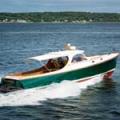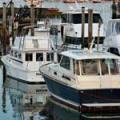Davis Boatbuilding and Furniture: Acorn 17
Photos courtesy Davis Boatbuilding & Furniture
 The Acorn 17 glides through the water, showing off its nicely lined-off planking.
The Acorn 17 glides through the water, showing off its nicely lined-off planking.
For some years now, Blue Hill has been hosting a one-day Maritime Heritage festival to celebrate the town’s maritime history and the significance of Blue Hill Bay.
Steve Brookman, one of the leaders of the Downeast Chapter of the Traditional Small Craft Association, is one of the organizers. As such he has gotten the chapter to be a prime sponsor and organize on-the-water activity for participants, giving rides and letting people try out small rowing and paddling boats.
This year, I towed my 45-year-old 13' Good Little Skiff Smile up to the show to give others a chance to row it themselves. It’s a great stable boat for a single rower and one or more passengers. When I arrived, the tide wasn’t up high enough to launch so I skidded her off the trailer onto a couple of rollers, parked the trailer, and went to see what was on land.
That’s when a long, slim lapstrake rowing boat caught my eye.
The boat was an Acorn 17, a plumb-stem, wine-glass stern, glued-lapstrake boat built on speculation by Elijah Davis, a Maine native with years of boat and furniture building experience. He is steering toward a full-time boatbuilding and wood-working business, known as Davis Boatbuilding and Furniture, with a shop in North Yarmouth.
His skills as a builder showed in this boat. He took Iain Oughtred’s design for an open 15' rowing boat, stretched it to 17' and added touches of his own, such as slightly cambered decks fore and aft to shed water toward the finely crafted bent coamings. Under each deck section, he added a bulkhead to create dry compartments in the bow and stern. Each bulkhead has a screw-on water-tight hatch so they can be used for storage.
 The flotation compartment decks are capped off by nicely shaped coamings.
The flotation compartment decks are capped off by nicely shaped coamings.
“I intended for this rowboat to be used for the Maine Island Trail, so dry storage flotation tanks are imperative,” Davis said.
Working from plans instead of a kit, his planking was impeccable as was his clean, neat work. Other alterations to Oughtred’s plans included adding a bit more depth to the plywood where cleats are mounted, and finely shaped thwart stanchions under the seats.
Looking at the Acorn that day at the festival, the bright blue painted bilge area caught my eye. Davis and I discussed the tapered sole boards mounted atop the laminated floor timbers, and how they might be best configured. Personally, I would opt for completely removable floor boards in sections, making cleaning and maintenance easy.
Oughtred, a Scottish designer, is one of the pioneers of light lapstrake construction that is suited to today’s users. Epoxy glue and high-grade plywood planking make a stiff durable structure possible, one that stays stable if it lives most of its life on a trailer. A number of designers and builders are producing these small-boat designs, the kinds of rowing and sailing boats that fly below the outboard-motorized or rotomolded plastic paddle craft of mainstream recreational boating. Some of Oughtred’s plans are available through WoodenBoat as are some kits through Hewes and Company of Blue Hill.
 The inner gunwale set off from the sheer plank with blocks provides lightweight stiffening. Seat knees are rigid light laminates. Stretchers or footbraces would be customized to suit the customer.
The inner gunwale set off from the sheer plank with blocks provides lightweight stiffening. Seat knees are rigid light laminates. Stretchers or footbraces would be customized to suit the customer.
Davis’s Acorn 17 is a stretched version of Oughtred’s 15-footer. It’s a classic plumb-stem, wineglass-stern type that’s often referred to as a Whitehall, as these were used as water taxis in New York Harbor. The Acorn 15 is a fine solo rowing boat or a boat to carry a passenger or two but can’t take advantage of the power of a pair of rowers. Davis chose the stretched version, which is as big a boat as a single rower can drive at hull speed, and is a pleasure for a rowing pair especially if there is a passenger or two. Oughtred drew a sailing rig for the Acorn 15, but that boat and the 17 are really rowing boats.
A sliding seat would make the boat a serious exercise machine, allowing a single rower to easily drive it to its maximum speed. I’d not use one of the metal drop-in rigs, which make it hard to use the boat for anything else. Instead, I’d have Davis make a removable slide that fits over the existing seat. The rower can remove it while underway if the sea kicks up. The boat is wide enough not to need outriggers. At over 100 pounds, she is a little heavy for roof topping without serious thought about how to get her up and down, and would go well on a light aluminum trailer.
While Oughtred draws plans by hand, the old way, he has had others digitizing the drawings, providing full-sized patterns and kits. Digitizing plans so that they can be sent as files has allowed designers to send plans all over the world. Parts can be cut for kits with CNC machines or full-size patterns can be provided. Both have made it possible for small-boat builders—both amateur and professional—to have a wealth of choices.
Davis is joining a number of Maine’s small-boat builders who specialize in these light glued craft. Among them, are Clint Chase, who designs and creates kits; Cottrell Boatbuilding; Bill Buchholz’s Apache Boatworks, best known for his iceboats; and Gardner Pickering, who runs the kit production side of Hewes and Company.
 Elijah Davis and his fiance, Amanda Wheeler, were on hand with the Acorn 17 at the 2023 Maine Boat & Home Show. Photo by Peach Frederick
Elijah Davis and his fiance, Amanda Wheeler, were on hand with the Acorn 17 at the 2023 Maine Boat & Home Show. Photo by Peach Frederick
A client working with these builders enters a dialog during which custom details can be added. Clients who don’t have the facilities, time, or skills to build one but who can do finishing work, might work with a builder to get a boat ready for paint, something that consumes up to half of the time on a build.
This would be the case where two customers got Buchholz to build their boats. One wanted a Clint Chase Drake design, and the other wanted a pair of Gloucester Gulls (Phil Bolger/Dynamite Payson boats). The buyers took delivery of the boats unfinished and did the sanding and painting themselves, something that they had the skills and facilities to complete.
Computer-aided design, plans that can be sent as files, and computer cutting machines coupled with epoxy glues and stable plywood have ushered in a new era in small-boat building. These tools have made small-scale boat building and large custom yachts possible and competitive when compared with similar fiberglass production boats. The good news: Buyers have more choices.
✮
Ben Fuller, curator emeritus of the Penobscot Marine Museum, has been messing about in small boats for a very long time, with boats ranging from high tech International Canoes to skin-on-frame kayaks.
Acorn 17 Specifications
LOA: 16'7"
LWL: 16'4"
Beam: 3'11"
Weight: 135 lbs.
Freeboard at oarlocks: 1'4"
Capacity: 2 persons + gear
Designer:
Ian Oughtred
www.oughtredboats.com
Builder:
Davis Boatbuilding & Furniture
160 Royal Road, North Yarmouth, ME
207-355-5187
www.davisboatbuilding.com
Related Articles
Share this article:
2023 Maine Boat & Home Show

Join Us for the Maine Boat & Home Show!
Art, Artisans, Food, Fun & Boats, Boats, Boats
August 11 - 13, 2023 | On the waterfront, Rockland, Maine
Click here to pre-order your tickets.
Show is produced by Maine Boats, Homes & Harbors magazine.















